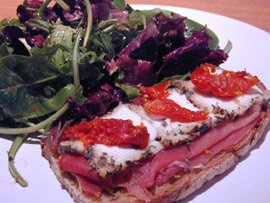I am ordinarily not a huge winter squash fan. I used to dislike sweet and savory together when I was little, and that seems to vaguely remain when it comes to pumpkin and its brothers and sisters. But I do love the look of them and how they come in all shapes, sizes and colors and look like a little munchkin tribe.
And the other day at the farmers’ market, I could not resist buying a big plump slice of bright orange courge musquée – also called courge muscade (literally nutmeg squash), which is your typical Jack-O-Lantern shaped pumpkin. I looked at it, and suddenly I knew : soup. That’s it. I will. Make. Soup.
After researching a little for inspiration – and this included washing my hands thoroughly to leaf with care through Stéphan’s precious Larousse Gastronomique, which he let me borrow under the absolute promise that I would take care of it as if it was my firstborn child – I came up with the following recipe.
We enjoyed this soup very much. The taste is made nicely complex by the different spices, and the sweetness of the onions complements that of the courge very well, without making the soup overly sweet in a this-should-be-served-for-dessert way. Will repeat!








